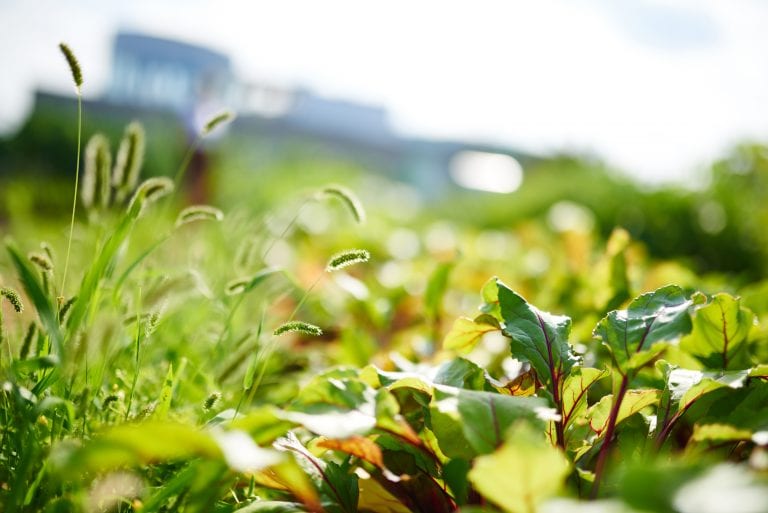Being at home shows us exactly why we need more green homes

With most of the nation now spending all their time at home, there are signs the public are increasingly waking up to the value of nature in the built environment.
Away from the supermarkets, the RHS has reported record sales of seeds and website traffic, as people look to ‘grow their own’ or spend more time in the garden. Likewise, local garden centres’ sales were up 40% prior to the shutdown, with local greenspaces controversially inundated with visitors.
This is not surprising given the mental health benefits of connecting with nature, biodiversity and green space. However, whilst some are lucky enough to have a garden and always have a small area on-hand to sit in the sun or relax surrounded by greenery, for many an opportunity to connect with nature at home is sadly absent.
In the times ahead, today’s experience should be an important catalyst for new policies and design to help encourage and promote nature in the built environment. When the Environment Bill eventually returns, and more councils look to follow Bristol in declaring ecological as well as climate emergencies, this period should be a valuable cue for calls to promote the mutual benefits of greening the built environment for both people and nature.
Healthy People, Healthy Planet
There is already a substantial body of well-established evidence on the benefits of green infrastructure, green space, greenery-in-design and nature to human health. However, there is also an important strand to this evidence which explores the link between enhancing biodiversity and our own wellbeing.
Studies have found that greater bird, butterfly and plant diversity increased the wellbeing benefits gained from those visiting the green space. Likewise, bird abundance and vegetation cover in urban areas were found to have reduced residents’ anxiety, stress, and depression. Increased tree cover has also been shown to have a positive relationship with mental wellbeing, the possible explanation being that tree cover acts as a psychological proxy for the perceived “naturalness” of an environment.
The importance of ‘naturalness’ or ‘urban greenery’ is of increasing relevance to the construction and property sector, not–least following Government proposals for biodiversity net gain in new development. The National Adaptation Programme specifically commends the goal of developing new green infrastructure to help enhance urban resilience to both heatwaves and flooding. Likewise both London and Paris have made urban greening key to their own climate resilience strategies.
The economic benefits of greenery-in-design are also being progressively recognised by the industry. Buyers are much more willing to pay more for properties in greener areas, and greenery has been shown to be a key ingredient in research measuring property attractiveness.
However, whilst policies to promote biodiversity are in the pipeline for new development through net gain, the question remains about what can be done for existing buildings.
Greening our cities
With over 40% of UK species in decline, it is vital that urban areas play their part. Indeed, the Environment Bill includes requirements for both the creation of Local Nature Recovery Strategies and Biodiversity reporting to cover the whole of England, therefore including urban areas and their respective local authorities.
Relevant to this, UKGBC recently released a sector ambition, calling for “by 2030 all buildings and infrastructure should, throughout their lifetime, be climate resilient and maximise environmental net gains, prioritising nature-based solutions”. We have also produced a range of green infrastructure case studies, illustrating what this can look like in practice. In addition, in the last few weeks UKGBC have received funding to create: “A framework for increasing nature-based solutions in urban areas: For climate resilience and environmental net gains“.
Both the Environment Bill and new attention from councils will generate significant opportunities to help realise this ambition, as their related plans and strategies are drafted. The next steps will also involve how to capitalise on the growing body of industry attention to biodiversity; particularly expressions of interest in how to weave this into retrofitting homes and how to incentivise both homeowners and businesses to maintain and promote green infrastructure.
Whilst we are living through strenuous and worrying times, one hope is that this experience will act as a much-needed wake-up call concerning the future of the built environment. With many of us now having to live, work and play in our homes likes never before – and the impacts of the climate crisis on the horizon – there has never been a better time to stress the need for a greener, healthier, more resilient built environment.
UKGBC have received funding this year to create: “A framework for increasing nature based solutions in urban areas: For climate resilience and environmental net gains”. For more information, please contact Robert.winch@ukgbc.org.
UKGBC have been invited to partner with Natural England to help develop a simplified biodiversity net gain metric for small developers. UKGBC are inviting interested members to participate in an industry steering group, to help formulate initial proposals for wider consultation. Interested members must ideally have experience of developments either 10 units or less or up to 5,000 sq. m or less. This includes any development type. For more information or to get involved, please contact either Philip.box@ukgbc.org or Robert.winch@ukgbc.org.
Related
Navigating the challenges around hard-to-recycle materials

What are the environmental impacts of construction materials? An introduction to Embodied Ecological Impacts

Why is social value so crucial when developing and managing commercial real estate?

Biodiversity Net Gain: Are you ready for the incoming legislation?

